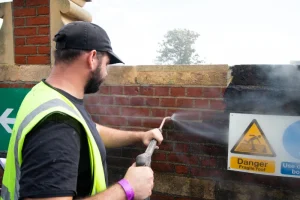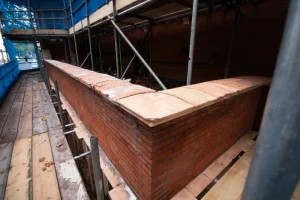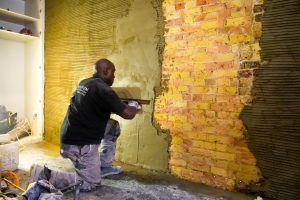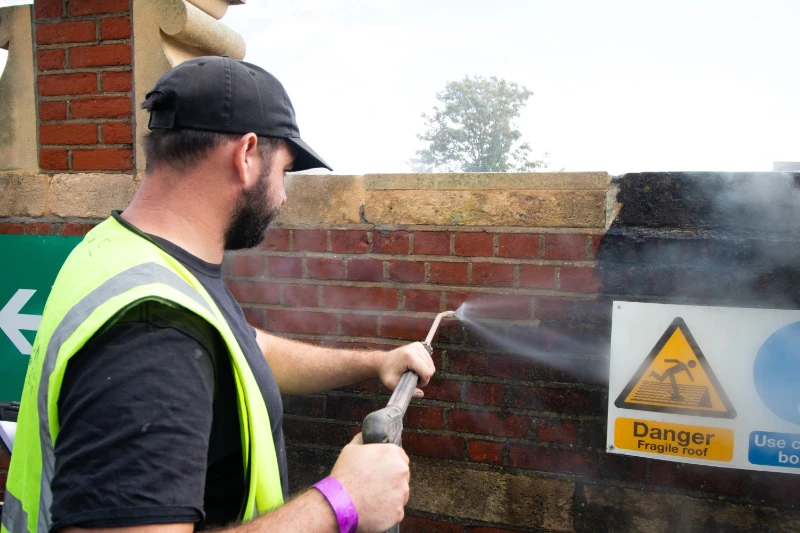Are dirty bricks or stubborn stains diminishing the appeal of your home? With our comprehensive guide to brick cleaning, discover how to tackle urban grime, graffiti, or the delicate task of historic brick preservation. Without any fluff, we dive straight into the methods that promise to leave your bricks looking their best, from straightforward maintenance to techniques for specific challenges.
Key Takeaways
- Each brick type, clay, facing, and historical brick, has unique cleaning requirements and maintenance methods to preserve its appearance and structural integrity.
- Regular brick maintenance is crucial for preventing dirt accumulation and structural issues. It involves consistent cleaning schedules and annual inspections to remove grime and avoid long-term damage.
- Efflorescence is a common problem for brickwork, but it can be effectively managed and prevented by proactive measures like using vapour barrier sheeting, ensuring proper drainage, and using low water absorption techniques in masonry construction.
Brick Types and Their Cleaning Needs

Each brick type possesses its unique cleaning requirements. For instance, clay bricks, known for their longevity, are susceptible to urban pollution and improper upkeep and thus require a gentle cleaning approach. On the other hand, facing bricks, which are designed to enhance the exterior appearance of buildings, require special attention due to their constant exposure to weather and pollution.
Let’s not forget about historical bricks, which require careful restoration techniques to maintain their original character. It’s also important to note that the cost of brick cleaning services may vary depending on the type of bricks and the complexity of the cleaning process. This is why choosing a reliable brick cleaning service from among the various brick cleaning companies is essential for the best results.
Given the unique challenges posed by London’s diverse architecture and urban environment, finding a specialized brick cleaning London service that understands these nuances can be crucial. In London, the mix of historical and modern buildings, each with different types of bricks, underscores the importance of selecting a cleaning service well-versed in a variety of cleaning techniques to preserve the integrity and appearance of the brickwork across the city.
How to Care for Clay Brick
Clay bricks necessitate particular care to maintain their appearance and integrity. Cleaning should ideally start no sooner than seven days after the brickwork is completed and the mortar is set. A detergent solution and a nylon brush are your best friends for this task. Avoid wire brushes or metal tools as they can damage the brick face.
A diluted solution of a proprietary acid cleaner or a non-acidic cleaner designed specifically for clay bricks can come in handy for tough stains. And remember, regular maintenance is key to tackling common challenges such as discolouration due to dirt and debris, as well as the growth of algae and mildew.
How to Care for Facing Bricks
Facing bricks presents a unique set of challenges. They must withstand various weather conditions, which can affect their structural integrity. For instance, painted or decorated brick finishes can retain moisture, increasing the risk of frost damage. Hence, choosing the right brick cleaning method is crucial to prevent damage.
A detergent solution with a nylon brush, brick acid cleaners for efflorescence, and a homemade mixture of dish soap, white vinegar, and warm water can be quite effective for general dirt, grime, mortar and cement deposits.
How to Care for Historical Bricks
Conversely, historical bricks necessitate a gentle approach. They carry a piece of history, and preserving their originality is paramount. Non-acidic-based cleaners and soft-bristle brushes or sponges are the way to go, as they prevent potential damage from abrasive cleaning systems. Also, when restoring damaged bricks, it’s essential to use methods that do not change their appearance. For instance, repointing – repairing brick and mortar without removing the bricks – can help preserve their originality. And remember, to mitigate weathering damage, limewash, waterproofing, and prompt repair of any pre existing damages are your best allies.
The Essentials of Regular Brick Maintenance
Having discussed the specific cleaning needs of various brick types, we will now explore the fundamentals of regular brick maintenance. This involves:
- Cleaning the brickwork to eliminate dirt, grime, and weather damage
- Conducting an annual inspection of the masonry
- Cleaning with mild detergent
- Unclogging weep holes
Regular cleaning is crucial for removing dirt, grime, stains, and other unwanted elements that accumulate on the brick surface over time. It also aids in preventing the buildup of stubborn stains and other contaminants that may lead to long-term damage.
Prevent Dirt Accumulation
A key aspect of brick maintenance is preventing dirt accumulation. This can be achieved by using interior dust and brick sealer, performing regular dusting and vacuuming, and properly cleaning with water.
The design and placement of structures in the landscape can also significantly affect the cleanliness of bricks. For instance, poor drainage or improperly sloped structures can result in moisture retention in the brickwork, leading to efflorescence and increased dirt accumulation.
Schedule Regular Cleanings
Consistent cleaning is paramount for maintaining bricks. It’s advisable to clean brick surfaces at least once a year to uphold their visual appeal and avert potential deterioration. A detergent solution and a nylon brush should be used for cleaning, and wire brushes or metal tools should be avoided to prevent damage to the brick face.
Also, consider the impact of seasonal changes on the cleaning schedule. Summer, for instance, is considered the optimal time for cleaning brickwork due to potentially faster drying times and lower chances of rainfall.

How to Remove Different Stains on Brickwork
Your brickwork can harbour various types of stains. Don’t worry, though. These stains can be effectively treated with the right cleaning solutions and techniques.
1. Paint Removal from Bricks
Paint stain is a prevalent issue for brick owners. Perhaps you’ve recently purchased a historic brick house with layers of old paint, or maybe your kids got a little too creative with their art project on your brick wall. Whatever the case, it’s essential to know how to remove paint from bricks safely and efficiently. And that’s exactly what we’ll cover in this section.
Safety Precautions for Paint Removal
Prioritising safety is essential in all paint removal processes. You should refrain from pressure washing and sandblasting, as these can damage the bricks. Instead, it’s recommended to use paint strippers or gel strippers for effective removal. If the paint is lead-based, it’s crucial to avoid sanding or chipping to prevent exposure to lead.
Choose the Right Paint Removal Method
After ensuring safety measures are in place, the next step is to select the appropriate paint removal method. Factors such as area size and location can influence your decision. For instance, smaller interior areas often favour gel paint strippers, while larger exterior areas may benefit from mechanical methods such as pressure washing or sandblasting.
Remember, the type of paint used also determines whether chemical or mechanical methods are more suitable.
2. Efflorescence
The challenge of efflorescence, which is crystalline salt deposits on brick surfaces due to the evaporation of water carrying soluble alkali salts, is significant. It can manifest as a powdery white or yellow deposit on your bricks caused by the migration of salts to the surface of the bricks, can affect the strength of the bricks, and can lead to the growth of black mould fungus. Here are some steps you can take:
- Use a stiff brush to scrub the affected area.
- Rinse the bricks with water.
- If necessary, use a chemical cleaning method. Mix 1 part muriatic acid with 12 parts water and apply it to the affected area. Remember to pre-soak the wall with fresh water before applying the acid solution. By following these steps, you can effectively manage efflorescence on your bricks.
The challenge of efflorescence, which is crystalline salt deposits on brick surfaces due to the evaporation of water carrying soluble alkali salts, is significant. It can manifest as a powdery white or yellow deposit on your bricks caused by the migration of salts to the surface of the bricks, can affect the strength of the bricks, and can lead to the growth of black mould fungus.
Tips to Prevent Efflorescence
- Using vapour barrier sheeting between masonry construction and the ground
- Maintaining good site practices such as proper curing, drainage, and ventilation
- Ensuring low water absorption through carefully graded aggregates, a low water-to-cement ratio, and proper compaction of the masonry units
3. Lime and Metallic Stains
Lime stains result from water infiltration through minute holes or cracks in the brick, leading to the dissolution of calcium carbonate present in the mortar or bricks. Metallic stains, on the other hand, can be attributed to limescale, oxidation, and sulphation originating from metallic surfaces.
These stains can be effectively treated using a detergent solution applied with a nylon brush. Remember to avoid using a wire brush or metal tools as they can cause damage to the brick face.
4. Cement Removal from Bricks Without Damage
If not correctly removed, stubborn cement stains can damage bricks. So, how do you safely remove cement from bricks? Let’s find out.
Soften the Cement Deposits
Before you can remove cement, you need to soften it. This can be done by tapping with a chisel and hammer, using vinegar as a mortar dissolver, or applying diluted cleaning solutions to the affected areas. Once the cement is loosened, non-abrasive scrubbing tools can be used to remove it. Remember to observe safety measures when using chemical methods to soften cement.
Final Touches for a Clean Finish
Once you’ve removed the cement, it’s time for the final touches. To achieve a polished finish, apply a mixture of 1 cup of ammonia, 1/4 cup of all-purpose cleaner, and 8 cups of water. Also, consider applying a sealant with a matte finish to preserve the brick’s authentic texture.
With these final touches, you’ll have clean brickwork and a polished finish that will make your bricks look as good as new.
5. Fireplace Stains Brick Cleaning
While brick fireplaces enhance any home’s beauty, they demand particular cleaning techniques. Soot and smoke stains not only affect the aesthetics of your fireplace but can also contribute to the deterioration of the brickwork if not consistently removed.
Let’s take a look at how you can effectively clean and maintain your brick fireplace.
Removing Soot and Smoke
Soot and smoke stains can be quite stubborn, but they can be effectively removed with the right approach. One way to do this is by creating a cleaning paste using either baking soda or cream of tartar mixed with a small amount of water. Apply the paste to the stained areas, let it sit for a few minutes, and then scrub it off. This method is not only effective but also safe for your bricks.
How to Maintain a Clean Fireplace
Prevention is always preferable, as it is generally more effective in avoiding potential risks or harm. It is better to take steps to prevent negative outcomes than to deal with them after they occur. Hence, regular maintenance is key to keeping your brick fireplace clean and well-functioning. Sweep or vacuum before each use if you’re using the fireplace daily. If it’s just occasional use, a quick clean after each use should suffice.
And don’t forget the annual deep clean. This involves a more thorough cleaning using a scrubbing brush and specific fireplace maintenance tools. These tips allow you to enjoy a cosy fire without worrying about stubborn stains.
How to Restore Aged Bricks
Historic bricks exude a distinct charm, but they present their own set of challenges in cleaning and maintaining brick walls. But don’t worry – with careful restoration techniques, you can bring back the glory of your aged bricks.
Assess the Condition of Old Mortar
When restoring aged bricks, it’s crucial to assess the condition of the old mortar and mortar joints. This involves conducting a visual inspection to identify any previous tuckpointing or repairs, as well as examining the hardness or softness of the brick and mortar. This will help you determine the best restoration approach for your bricks and ensure that the original character of the bricks is maintained.
Apply Gentle Cleaning Approaches
Aged bricks require a softer touch when it comes to cleaning. Here are some methods you can use:
- Gentle scrubbing with a nylon-bristled brush
- Using soft-bristle brushes or dry sponges to brush away dirt
- Chemical cleaning
- Gentle hand washing with a soft-bristled brush and mild detergent
- Using a mix of dish soap and salt for gentle surface-level cleaning
With these gentle cleaning approaches, you can preserve the integrity of your aged bricks and prolong their lifespan.

Safe and Efficient Brick Cleaning Solutions
Having discussed the specific cleaning needs of various brick types and essential maintenance measures, we will now examine some safe and efficient brick cleaning solutions. Many methods can help you keep your bricks in top shape, from pressure washing to gentle hand washing.
Acid-Free Cleaning Options
If you prefer a more environmentally friendly approach and do not want to use a brick acid cleaner, acid-free cleaning options are available. These methods, such as soda blasting, are efficient and safeguard the durability of your bricks. They are particularly useful for fragile substrates commonly found in historic building renovations.
Biodegradable Solutions
Biodegradable solutions offer an environmentally friendly approach to brick cleaning. They can conserve water and remove stubborn deposits without harming delicate surfaces. Plus, they are readily available from various suppliers, making them a convenient and eco-friendly choice.
Innovative Tools and Equipment
Innovative tools and equipment can also make the brick cleaning process more efficient and safer. For instance, the ThermaTech system uses superheated water to produce steam, effectively cleaning brick, stone, and masonry. Its gentle nature makes it appropriate for fragile substrates commonly found in historic building renovations. Plus, it efficiently eliminates paint and coatings without relying on harsh chemicals.
Mechanical vs. Chemical Cleaning
When it comes to brick cleaning, there’s always a debate between mechanical and chemical methods. Mechanical methods, such as abrasive cleaning methods like grit blasting, are efficient in removing surface deposits but can be labour-intensive and cause damage if used improperly.
On the other hand, chemical cleaning methods offer strong cleaning abilities but can be corrosive and environmentally harmful. Hence, choosing the method that best suits your needs and the type of bricks you’re dealing with is important.
Frequently Asked Questions
Is brick cleaning worth it?
Yes, brick cleaning is worth it. It can significantly improve the curb appeal of your building, making it more visually appealing. A better-looking building can have a positive impact in various ways.
What do bricklayers clean bricks with?
Bricklayers typically clean bricks with a hydrochloric acid solution to remove mortar stains, but it should only be done by trained professionals to avoid damaging the bricks.
Does WD 40 clean bricks?
No, WD-40 is not recommended for cleaning bricks as it could potentially discolour them. It’s best to use specialised brick cleaners or contact professional cleaners.
How do you clean exterior brick UK?
To clean exterior brick in the UK, use a hard bristle brush with soap and water, wear gloves, and consider using a solution of water and muriatic or boric acid for oily residues. Be cautious and consider safety goggles if available.
What are the different types of bricks?
The different types of bricks include clay bricks, facing bricks, and historical bricks, each with their unique cleaning requirements. Clay bricks, facing bricks, and historical bricks are the main types of bricks.
Final Thoughts
In conclusion, maintaining the aesthetics and durability of your brickwork requires consistent cleaning and proper maintenance. Whether you’re dealing with clay bricks, facing bricks, or historical bricks, it’s important to use the right cleaning methods and solutions. And remember, regular maintenance, safe paint removal, stain treatment, fireplace cleaning, and cement removal all contribute to preserving the glory of your bricks. With these tips and techniques, you can keep your brickwork looking as good as new for years to come.


